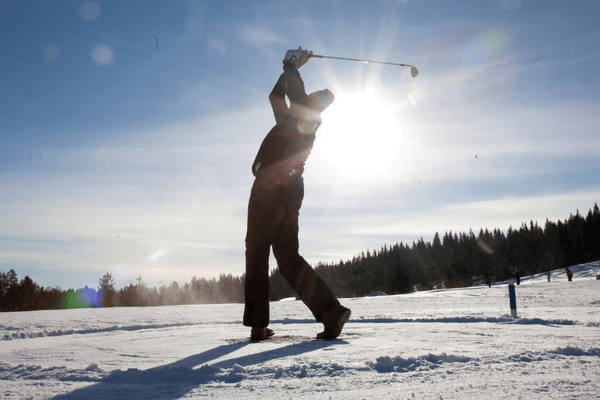Golf is a highly addictive sport. Sometimes, people will even brave the most extreme weather conditions just to get a round in.
While you can generally play golf in searing heat – so long as you are able to handle it – playing in very cold conditions is a whole different prospect and requires specialised clothes like thermals, beanies and additional layers.
But can the extreme cold have a negative impact on your clubs? And could storing your golf clubs in extremely cold conditions over winter actually be detrimental to their long term performance?
No, golf clubs won’t break in cold weather due to the temperature or conditions. While your shaft may flex differently in winter compared to warmer temperatures, it is highly unlikely below freezing temperatures will be the reason behind a club breaking.
Balls, however, can be more prone to cracking in colder temperatures, especially if stored outside or below freezing.
In this article, I’ll explain everything you need to know about storing your golf clubs during the colder months of the year.
Table of contents
How should I store my golf clubs in winter?
During winter, it’s best to store your golf clubs in a temperature-controlled environment, such as in a cupboard or closet within the home. Damp, humid conditions sometimes seen in a garage during winter may accelerate rusting, while below freezing temperatures can stiffen grips and cause them to crack or split.
If you live in a climate where golf is pretty much out of the question during winter, then it makes complete sense to remove them from your car or garage and tuck them away in a closet or storage location inside the house.
As long as it’s somewhere that will be maintained at a fairly stable temperature.
Can you play golf in 35 degrees Fahrenheit?
Yes, you can definitely play golf in temperatures down to 35 degrees Fahrenheit and around freezing, but it is crucial you take the correct precautions to remain safe. Ultimately, as long as the course is in a playable condition (no snow on the surface or frozen ground, for example) then the only limit is what your body can handle without being put at risk.
Golfers in the northern parts of the United States will usually push things pretty far, playing in low 30s temperatures that someone in, say, Florida or even Australia would think was insane.
It is important that you have the appropriate clothing though, with thermal layers from Under Armor being some of the best going around.
I’d also recommend some of those simple hand warmers too to help keep the blood flowing to your fingers.
An interesting point regarding golf in the depths of winter/at cold temperatures is actually raised by YouTube channel Mobile Clubmaker Golf and something I think anyone in a colder climate should think about.
He discusses the importance of the summer versus winter set up of your clubs if you are seeing large shifts in temperature across the year, as the depths of winter will likely lead to a reduction in swing speed so great you might even want to opt for more flex in your shafts.
It makes sense, given that molecules and materials all shrink together and tighten in cold conditions, not to mention extra layers likely being a little more restrictive on the movement of your body.
Can golf clubs get damaged from cold weather?
No, it’s unlikely cold weather will damage golf clubs, with modern clubs holding up quite well in temperatures down to freezing levels. While poorly struck shots may hurt your hands more, the actual tolerance of clubs to take blows well away from the sweet spot is quite high, even in freezing conditions.
The length of time clubs are exposed to freezing temperatures out on course during a winter round isn’t going to be enough to do any damage.
The main thing is to avoid moisture, so if the cold weather is paired with rain, use a good rain cover and umbrella, as well as drying them off in full after your game.
Some people have reported breaking or damaging golf balls (rather than clubs) more frequently during the winter, but this occurs most often at the range where those balls are struck thousands of times anyway.
Does cold weather affect the performance of golf clubs?
Yes, cold weather will affect the performance of your clubs, but this is more likely tied to the way you swing the club when it’s colder, rather than the club itself. For example, you may lose distance in colder weather because of reduced swing speed or see a shorter ball flight due to the resistance of colder, denser air.
There is a suggestion that swapping for more flex in your shafts is a good idea in winter, but the cost of this would be enough to turn most golfers away.
The fact bulky winter gear and stiff joints will lower your swing speed and contribute to shorter distances can be easily remedied by clubbing up during the colder months.

Balls will likely compress less when it’s extremely cold, which is yet another reason why a little more club is needed when the temperature drops.
All the while, these changes are brought about by the conditions themselves, more so than an actual drop off in the performance of your gear.
Is it OK to leave golf clubs in the trunk of your car?
No, it is never a good idea to leave your golf clubs in the back of your car for extended periods. Given that extreme temperature fluctuations can have negative effects on the longevity of your clubs, they should always be removed and stored in a temperature-controlled location when not in use.
As mentioned earlier, below freezing or humid environments can cause rusting or damage to the grips of your clubs, so leaving them in the trunk of your car over winter can put them at increased risk.
At the other end of the scale, the extreme heat found in the trunk of your car during summer is possibly more dangerous to your clubs, as the remarkably high temperatures seen on a very hot day can break down the epoxy that keeps clubhead and shaft married together.
While clubs manufactured within the last 10 years are far more resistant to this issue than older models, it’s still not worth leaving your golf clubs in a hot car any longer than you need to.
Final message
There’s nothing more frustrating than a patch of bad weather keeping you off of the golf course, so many people in colder climates will often push the limits of playing in frosty conditions.
Luckily, there is enough great gear out there to keep you warm and safe on course in colder temperatures, and by storing your clubs correctly when they do go dormant for the winter, you’ll ensure you benefit from a well-performing set of sticks once the weather warms up again.


